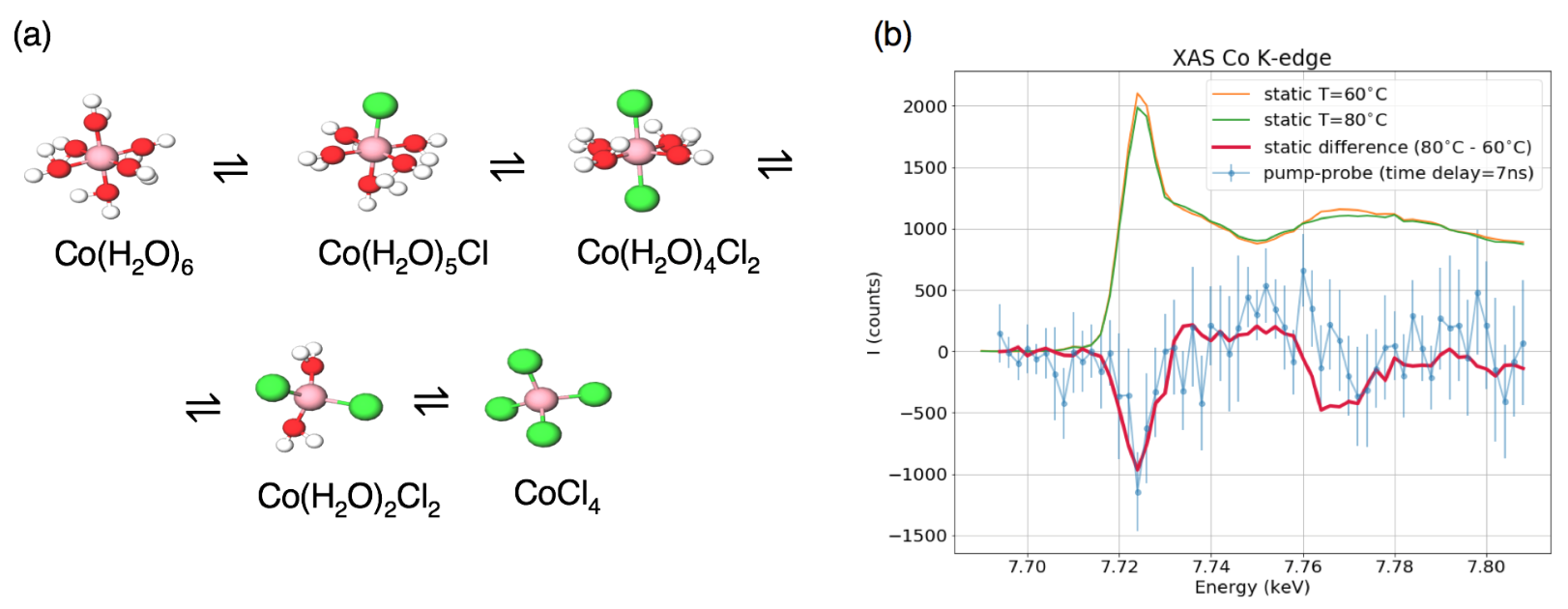Towards time-resolved laser T-jump/X-ray absorption probe spectroscopy
Most of (bio)chemical reactions in Nature and in industrial processes are driven by thermal effects that bring the systems above the barrier for reaction. This process can also be triggered by the Temperature-jump (T-jump) method. The latter is ideal in aqueous solvents, where, by directly exciting the water high frequency vibrational and/or bending modes,[1-3] it leads to an ultrafast (2-5 ps) increase in the temperature of the irradiated volume, locally triggering chemical reactions. Implementing the laser T-jump method with X-ray techniques in the picosecond time domain would add element-specificity and structural-sensitivity, helping the identification of the intermediates of reactions. Here we demonstrate the laser T-jump/X-ray absorption probe method to probe the sequential substitution process of a Cobalt center from the octahedral aqueous complex to the tetrahedral chlorinated species: [Co(H2O)6]2+ + 4Cl− ⇌ [CoCl4]2− + 6H2O. This reaction had previously been investigated in the optical domain [4], and it proceeds via several intermediate steps (Fig.1(a)) through equilibria that can be controlled by changing the temperature and/or the chloride concentration [5].

The experiments were carried out at the Swiss Light Source (SLS), pumping the aqueous solution at 1064 nm and probing the samples (consisting of an aqueous solution of CoCl2 at a concentration of [Co2+]=500mM and [Cl-]=8M) by Co K-edge absorption spectroscopy. Given the jet speed (6 m/s) and the laser and X-rays spot sizes (laser spot: 70x60 µm2, X-rays spot: 50x50 µm2 ), the laser repetition rate was set to 65 kHz to avoid multiple pumping of the same volume of solution and to increment the energy per pulse deposited onto the sample. Under these conditions, the local T-jump, estimated according to ref. [1], corresponds to a ΔT=0.3K when using a laser fluence of 240 mJ/cm2. Figure 1(b) shows the steady-state Co K-edge spectra of the solution at 2 different temperatures, along with the transient spectrum at 7 ns time delay of a 60∘C solution. The difference of the steady state spectra is shown in red and it reproduces nearly all the features of the transient (blue line). This shows that even a mild increase in temperature can be monitored with great sensitivity by X-ray absorption spectroscopy. Further details of this study will soon be published [6]. The implementation of the T-jump method for time-resolved X-ray probing is not limited to X-ray absorption spectroscopy but it also includes X-ray emission and X-ray scattering. Given the ultrafast (2-5 ps) time scale of the laser heating in aqueous solutions, the present results open very promising perspectives for the investigation of temperature-driven biochemical processes at X-ray Free electrons lasers.
[1] Z. Wang, Y. Pang, D. D. Dlott , The Journal of Physical Chemistry A, 2007, 111(17), 3196-3208.
[2] Wernet, P. et al., Applied Physics A, 2008, 92(3), 511-516.
[3] H. Ma, C. Wan, A. H. Zewail, Journal of the American Chemical Society, 2006, 128(19), 6338-6340.
[4] H. Ma, C. Wan, A. H. Zewail, Proceedings of the National Academy of Sciences, 2008, 105(35), 12754-12757.
[5] W. Liu et al., Geochimica et Cosmochimica Acta, 2011, 75(5), 1227-1248.
[6] O. Cannelli et al. – in prep.